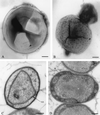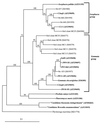Isolation of Gemmata-like and Isosphaera-like planctomycete bacteria from soil and freshwater
- PMID: 11772655
- PMCID: PMC126576
- DOI: 10.1128/AEM.68.1.417-422.2002
Isolation of Gemmata-like and Isosphaera-like planctomycete bacteria from soil and freshwater
Abstract
New cultured strains of the planctomycete division (order Planctomycetales) of the domain Bacteria related to species in the genera Gemmata and Isosphaera were isolated from soil, freshwater, and a laboratory ampicillin solution. Phylogenetic analysis of the 16S rRNA gene from eight representative isolates showed that all the isolates were members of the planctomycete division. Six isolates clustered with Gemmata obscuriglobus and related strains, while two isolates clustered with Isosphaera pallida. A double-membrane-bounded nucleoid was observed in Gemmata-related isolates but not in Isosphaera-related isolates, consistent with the ultrastructures of existing species of each genus. Two isolates from this study represent the first planctomycetes successfully cultivated from soil.
Figures


Similar articles
-
Unraveling the extent of diversity within the order Planctomycetales.Appl Environ Microbiol. 1995 Jun;61(6):2270-5. doi: 10.1128/aem.61.6.2270-2275.1995. Appl Environ Microbiol. 1995. PMID: 7793948 Free PMC article.
-
Phylogenetic diversity, polyamine pattern and DNA base composition of members of the order Planctomycetales.Int J Syst Bacteriol. 1999 Apr;49 Pt 2:689-96. doi: 10.1099/00207713-49-2-689. Int J Syst Bacteriol. 1999. PMID: 10319492
-
Aquisphaera giovannonii gen. nov., sp. nov., a planctomycete isolated from a freshwater aquarium.Int J Syst Evol Microbiol. 2011 Dec;61(Pt 12):2844-2850. doi: 10.1099/ijs.0.027474-0. Epub 2011 Jan 14. Int J Syst Evol Microbiol. 2011. PMID: 21239565
-
Determining the bacterial cell biology of Planctomycetes.Nat Commun. 2017 Apr 10;8:14853. doi: 10.1038/ncomms14853. Nat Commun. 2017. PMID: 28393831 Free PMC article. Review.
-
Planctomycetes as Host-Associated Bacteria: A Perspective That Holds Promise for Their Future Isolations, by Mimicking Their Native Environmental Niches in Clinical Microbiology Laboratories.Front Cell Infect Microbiol. 2020 Nov 30;10:519301. doi: 10.3389/fcimb.2020.519301. eCollection 2020. Front Cell Infect Microbiol. 2020. PMID: 33330115 Free PMC article.
Cited by
-
Phylogenetic analysis and in situ identification of bacteria community composition in an acidic Sphagnum peat bog.Appl Environ Microbiol. 2006 Mar;72(3):2110-7. doi: 10.1128/AEM.72.3.2110-2117.2006. Appl Environ Microbiol. 2006. PMID: 16517660 Free PMC article.
-
Temporal variability of coastal Planctomycetes clades at Kabeltonne station, North Sea.Appl Environ Microbiol. 2011 Jul;77(14):5009-17. doi: 10.1128/AEM.02931-10. Epub 2011 Jun 3. Appl Environ Microbiol. 2011. PMID: 21642408 Free PMC article.
-
Paludisphaera soli sp. nov., a new member of the family Isosphaeraceae isolated from high altitude soil in the Western Himalaya.Antonie Van Leeuwenhoek. 2020 Nov;113(11):1663-1674. doi: 10.1007/s10482-020-01471-w. Epub 2020 Sep 16. Antonie Van Leeuwenhoek. 2020. PMID: 32936355
-
Metagenomic Analysis of Garden Soil-Derived Microbial Consortia and Unveiling Their Metabolic Potential in Mitigating Toxic Hexavalent Chromium.Life (Basel). 2022 Dec 13;12(12):2094. doi: 10.3390/life12122094. Life (Basel). 2022. PMID: 36556458 Free PMC article.
-
Frigoriglobus tundricola gen. nov., sp. nov., a psychrotolerant cellulolytic planctomycete of the family Gemmataceae from a littoral tundra wetland.Syst Appl Microbiol. 2020 Sep;43(5):126129. doi: 10.1016/j.syapm.2020.126129. Epub 2020 Jul 30. Syst Appl Microbiol. 2020. PMID: 32847778 Free PMC article.
References
-
- Bauld, J., and J. T. Staley. 1976. Planctomyces maris sp. nov.: a marine isolate of the Planctomyces-Blastocaulis group of budding bacteria. J. Gen. Microbiol. 97:45–55.
-
- Franzmann, P. D., and V. B. D. Skerman. 1984. Gemmata obscuriglobus, a new genus and species of budding bacteria. Antonie Leeuwenhoek 50:261–268. - PubMed
Publication types
MeSH terms
Substances
Associated data
- Actions
- Actions
- Actions
- Actions
- Actions
- Actions
- Actions
- Actions
LinkOut - more resources
Full Text Sources
Molecular Biology Databases

